303. The
design of the G tablet
seems to have
necessitated 27
glyphs in the 4th
(unlucky) line.
|
a1 |
30 |
30 (+1) |
b1 |
26 |
26 |
|
a2 |
29 |
59 (+ 1) |
b2 |
35 |
61 |
|
a3 |
24 |
83 (+ 1) |
b3 |
30 |
91 = 7 *
13 |
|
a4 |
27 |
110 (+
1) |
b4 |
33 |
124
= 4 * 31 |
|
110 +
124 =
234 = 13
* 18 |
|
a5 |
30 |
140 |
118 |
b5 |
29 |
153 |
118 |
|
a6 |
29 |
169 |
b6 |
28 |
181 |
|
a7 |
34 |
203 |
b7 |
31 |
212 |
|
a8 |
26 |
229 |
b8 |
30 |
242 |
|
sum |
229 =
111 + 4
* 29˝ |
sum |
242 =
124 + 4
* 29˝ |
... Interestingly, since
another meaning of
shi is 'death', the
number 4 is considered
unlucky. For example,
the floor numbering in
hotels sometimes jumps
mysteriously from 3 to
5; it is also considered
unlucky to give four of
something as a present
...
|
JUNE 13
(*84) |
14 |
15 |
16 |
17 (168
= 2 *
84) |
18 |
19 (*90) |
 |
 |
 |
 |
 |
 |
 |
|
Ga4-1
(68 +
16) |
Ga4-2 |
Ga4-3 |
Ga4-4 |
Ga4-5
(88) |
Ga4-6 |
Ga4-7
|
|
υš
Hydrae
(148.4),
RAS
ELASET
BOREALIS
(Northern
Head of
the
Lion) =
μ Leonis
(148.7)
*107 =
*148.4 -
*41.4 |
TSEEN KE
(Heaven's
Record)
= φ
Velorum
(149.9) |
ν Leonis
(150.1),
π Leonis
(150.6) |
υ˛
Hydrae
(151.8) |
Al
Jabhah-8
(Forehead)
/
Maghā-10
(Bountiful)
/
Sharru-14
(King)
10h
(152.2)
AL
JABHAH =
η Leonis
(152.4),
REGULUS
(Little
King) =
α Leonis
(152.7)
*111 =
*152.4 -
*41.4 |
λ Hydrae
(153.2) |
ADHAFERA
(Forehead)
= ζ
Leonis,
TANIA
BOREALIS
= λ
Ursae
Majoris,
SIMIRAM
= ω
Carinae
(154.7) |
|
Aug 16
(*148) |
17 (229) |
18 |
19 |
20
(*152) |
21 |
22 |
|
°Aug 12
(*144) |
13 (225) |
14 |
15 |
16
(*148) |
17 |
18 |
|
'July 20
(*121) |
21 |
22 / 7 |
23 |
24
(*125) |
25 |
26 |
|
"July 6
(*107) |
7 |
8 |
9 |
Anakena
10
2nd Te
Pou |
"July 11 |
12 (193) |
|
2nd time
at Hanga
Te Pau |
| Egyptian menchet |
 |
Phoenician lamedh |
 |
Greek lambda |
Λ (λ) |
|
... Wikipedia has no information regarding the origin of the Phoenician lamedh, but the Egyptian 'cloth' hieroglyph (menchet) is - I suggest - related to the 4 upside down sky pillars. I.e. the basic element of the 'covering' hieroglyph could have indicated darkness:


... Men's spirits were thought to dwell in the Milky Way between incarnations. This conception has been handed down as an Orphic and Pythagorean tradition fitting into the frame of the migration of the soul. Macrobius, who has provided the broadest report on the matter, has it that souls ascend by way of Capricorn, and then, in order to be reborn, descend again through the 'Gate of Cancer'. Macrobius talks of signs; the constellations rising at the solstices in his time (and still in ours) were Gemini and Sagittarius: the 'Gate of Cancer' means Gemini ...
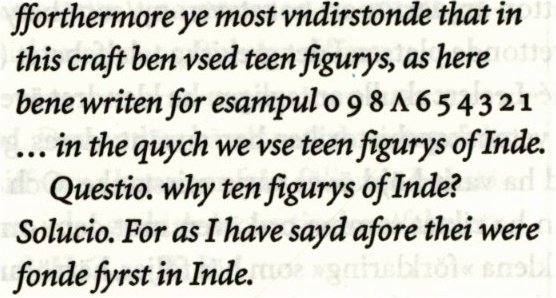

From the year 755 (when Cancer had been at July 11 according to the Mayas) to AD 1842 (my assumed baseline for the rongorongo texts) there were around (1842 - 755) / 71 = 15 precessional days. This seems to point to the time of the Bull, when in JANUARY 31 the old year would end (terminate). 192 (JULY 11) - 31 = 161 (JUNE 10):
... Midsummer is the flowering season of the oak, which is the tree of endurance and triumph, and like the ash is said to 'court the lightning flash'. Its roots are believed to extend as deep underground as its branches rise in the air - Virgil mentions this - which makes it emblematic of a god whose law runs both in Heaven and in the Underworld ... The month, which takes its name from Juppiter the oak-god, begins on June 10th and ends of July 7th. Midway comes St. John's Day, June 24th, the day on which the oak-king was sacrificially burned alive. The Celtic year was divided into two halves with the second half beginning in July, apparently after a seven-day wake, or funeral feast, in the oak-king's honour ... |
|
|
... He
got up,
the path
went
uphill,
and he
came
(back)
to the
house.
It was
dark
when he
reached
the
house.
When he
came to
the yam
plantation
of
Kuukuu,
he sat
down.
Night
was
falling.
Ira
asked
Makoi
the
following
question:
'How did
you fare
when you
wandered,
when you
went
searching,
when you
found
yourself
on the
path of
the
dream
soul of
the
father?'
Makoi
replied,
'There
are
indeed
all
those
places.
I did
not
forget
them at
all (?
kai
viri kai
viri)
when I
saw them
(text
corrected,
i-ui-nei).
I alone
saw no
fewer
than
four of
my
[sic!]
places,
and I
returned
here
only
because
night
was
falling.'
Then
Ira
spoke
again:
'How did
you name
them,
last-born?'
Makoi
replied,
'This is
what
happened,
this is
how I
gave the
names. I
wrote (ta)
Te
Manavai
A Hau
Maka
on the
surface
of a
banana
leaf (kaka),
and this
is how I
left
it.'
This is
how
Makoi
remembered
it. No
sooner
had he
said
this,
when
Ira
gew
angry
and
quarrelled
with
Makoi.
He said
the
following
(to
him):
'You did
not pay
attention,
last-born,
and you
did not
give the
(full)
name.
This is
how it
should
be: the
Manavai
of Hau
Maka of
Hiva,
in
memory (mo
aringa
ora)
of the
father,
of his
dream
soul.'
Makoi
replied,
'In
Hiva
the land
belongs
to him -
this
land
here is
mine,
not
his!'
[E:21]
They
stayed
(there
longer).
On
the
fifth
day of
the
month of
July (Anakena)
[day 227
at the
time of
rongorongo],
they all
got up,
went
downhill,
went on,
and
reached
Hanga Te
Pau.
They
took
their
provisions
with
them,
carrying
them on
their
shoulders,
went on,
and
reached
Te Pou.
They
made
camp and
slept in
Te Pou
on the
tenth of
the
month of
July (Anakena).
Then
they all
got up,
carried
their
provision
on their
shoulders,
went
straight
ahead,
and
followed
the path
of the
dream
soul of
Hau
Maka.
They
came to
Hua
Reva
and
said,
This is
Hua
Reva A
Hau Maka!
There
were
*111 (Anakena
10)
- *81 (Hanga
Te Pau)
= 30
right
ascension
days
from
their
Landfall
to 10h,
from
Ga2-28
(58) to
Ga4-5
(88).
From
Landfall
to the
2nd time
they
reached
Hanga
Te Pau
there
were 186
- 161 =
25 days,
suggesting
Hanga
Te Pau
was a
dark
regenerativ
time
belonging
to
Saturn. |
|
CLOSE TO
THE FULL
MOON: |
|
DEC 13 |
14
(*268) |
15 |
16 (350) |
17 |
18 |
19 |
|
Poko Uri |
Te
Manavai |
Te
Kioe Uri |
Te
Piringa
Aniva |
Te Pei |
7. Te
Pou |
Hua
Reva |
|
KUH
(Weeping)
= μ
Capricorni
(331.4),
γ Gruis
(331.5)
*290 =
*331.4 -
*41.4 |
no star
listed
(332) |
η Piscis
Austrini
(333.4)
*292 =
*333.4 -
*41.4 |
22h
(334.8)
KAE UH
(Roof) =
ο Aquarii
(334.0),
AL
KURHAH
(White
Spot) =
ξ Cephei
(334.4),
SADALMELIK
(Lucky
King) =
α
Aquarii,
AL
DHANAB
(The
Tail) =
λ Gruis
(334.6),
ι
Aquarii,
ν Pegasi
(334.7)
*293 =
*334.4 -
*41.4 |
ι Pegasi
(335.0),
ALNAIR
(The
Bright
One) = α
Gruis
(335.1),
μ Piscis
Austrini,
υ Piscis
Austrini
(335.3),
WOO
(Pestle)
= π
Pegasi
(335.7),
BAHAM =
θ Pegasi,
τ Piscis
Austrini
(335.8) |
ζ Cephei
(336.2),
λ Cephei
(336.3),
-/270
Lac.
(336.7),
λ Piscis
Austrini
(336.8) |
μ Gruis
(337.0),
ε Cephei
(337.2),
1/325
Lac.
(337.3),
ANCHA
(Haunch)
= θ
Aquarii
(337.4),
ψ Oct.
(337.5),
α
Tucanae
(337.9) |
|
Febr 15
(2-15) |
16 |
17 (14 *
29˝) |
18 (414) |
19 |
20 (*336
= 4 *
84) |
21 (52) |
|
°Febr 11 |
12 |
13 |
2-14 |
15 |
16
(*332) |
17 (413) |
|
'Jan 19
(384) |
20 |
21 |
22 |
23
(*308) |
24 |
25 |
|
"Jan 5 |
6 |
7 (372) |
8 |
9 |
Tua Haro
10
(*295) |
11 |
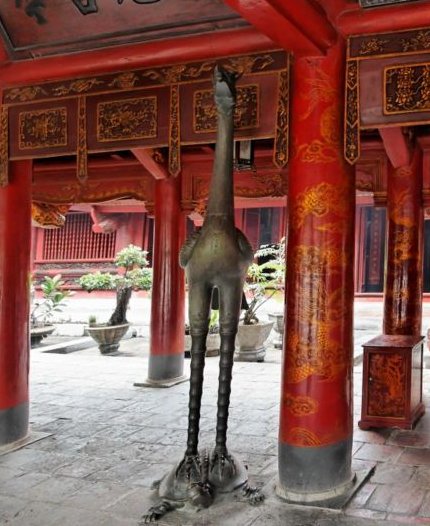
..
Horapollo,
the
grammarian
of
Alexandria,
about
A.D.
400,
tells us
that the
crane
was the
symbol
of a
star-observer
in Egypt
... |
|
JUNE 20 |
SOLSTICE |
22 (*93) |
23 (174) |
 |
 |
 |
 |
|
Ga4-8 |
Ga4-9 |
Ga4-10 (93) |
Ga4-11
(Tama) |
|
ALGIEBA (The
Mane) = γ
Leonis, q
Carinae
(155.5) |
TANIA AUSTRALIS
= μ Ursae
Majoris
(156.0),
GHOST OF JUPITER
= NGC3242 Hydrae
(156.8) |
Extended Net-26b
(Ox)
μ Hydrae
(157.1) |
Maru-sha-arkat-Sharru-15
(4th Son behind
the King)
SHIR (Possessing
Luminous Rays) =
ρ Leonis
(158.9) |
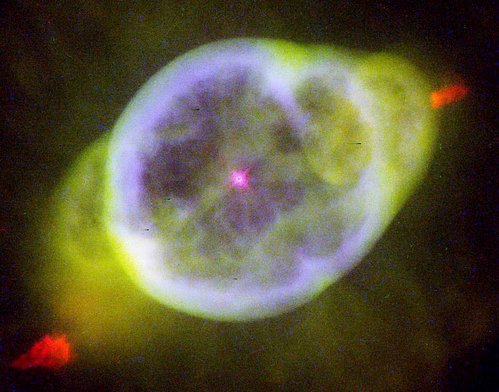 |
|
... Allen does
not mention
Achird and
he has no other
name for
η
Cassiopeiae, but
I guess the star
could be
connected with
α
Leonis, Regulus,
once named
Achir
(Possessing
Luminous Rays):
Naturally
sharing the
character of its
constellation as
the
Domicilium Solia,
in Euphratean
astronomy it was
Gus-ba-ra,
the Flame, or
the Red Fire, of
the House of the
East; in
Khorasmia,
Achir,
Possessing
Luminous Rays;
and throughout
classical days
the supposed
cause of the
summer's heat, a
reputation that
it shared with
the Dog-star ... |
|
Aug 23 |
24 (4 * 59) |
25 (*157 = *471
/ 3) |
26 |
|
°Aug 19 |
20 (232) |
21 (*153) |
22 |
|
'July 27 (*128) |
28 |
29 (210) |
30 |
|
"July 13 |
14 |
15 (*116 = *348
/ 3) |
16 |
|
They went on and
reached
Akahanga,
took a look at
it and looked
around. They
said: This is
it! and gave the
name Akahanga
A Hau Maka.
They went on and
came to
Hatinga Te Kohe
(Sic!) and saw
that in this
place the
kohe plant
had been broken.
They all said,
Here it is, the
kohe
plant, troop of
young men! This
kohe plant had
been broken by
the feet of the
dream soul and
therefore they
gave the name
Hatinga Te Kohe
A Hau Maka.
They went on and
came to Roto
Iri Are.
Again they said,
Here it is,
Roto Iri Are
and named the
place Roto
Iri Are A Hau
Maka. They
went on and
reached Tama.
They looked
around and said,
This is Tama.
They gave the
name 'Tama,
an evil fish (he
ika kino), a
very long nose (He
ihu roroa).' |
|
CLOSE TO THE
FULL MOON: |
|
DEC 20 (354) |
SOLSTICE (*275) |
22 |
23 |
|
Akahanga |
Hatinga Te Kohe |
Roto Ire Are |
Tama |
|
... noho
hakahaga,
apathy. 4. =
haka. Pau.:
haga =
haka. 5.
Mgv.: haga,
a fish. Mq.:
haka, id. 6.
Mgv.: haga,
a fishtrap. Sa.:
faga, a
fish-trap,
bird-cage ...
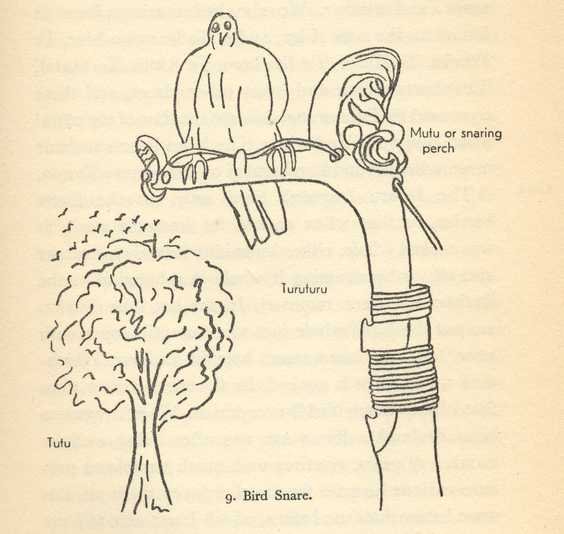
... Orion was
seen as a bird
snare by the
Maori, a place
where the 'bird'
got stuck and
couldn't move
away:
...
Pewa-o-Tautoru,
Bird-snare-of-Tautoru;
the
constellation
Orion in New
Zealand. The
Belt and Sword
form the perch,
te mutu
or te teke,
while Rigel is
the blossom
cluster,
Puanga, used
to entice the
unsuspecting
bird. To
visualize the
bird-snare we
must remember
that Orion, as
we see it in the
northern
hemisphere, is
upside down to
the view
obtained from
New Zealand
where Orion
stands in the
northern sky
...
... Due south of
the cove
of Anakena
was the cove
of Akahanga.
This suggests a
possible
interpretation
of Te Pei
and Te Pou
(the Pillar) as
a line drawn
between the
western and
eastern parts of
the island ...
.jpg) |
|
Al Sa'ad al
Ahbiyah-23 /
Shatabisha-25
ε Oct. (338.1),
ρ Aquarii
(338.2), 2/365
Lac. (338.5),
SADACHBIA (Lucky
Star of Hidden
Things)
= γ Aquarii
(338.6), π Gruis
(338.9) |
β/172 Lac.
(339.2), 4/1100
Lac. (339.4), π
Aquarii (339.5)
CASTOR (α
Gemini)
*298 = *339.4 -
*41.4
*339 = *275 +
*64 |
δ Tucanae
(340.1), ρ
Cephei (340.2),
ν Gruis (340.3),
ζ Aquarii, δ
Gruis (340.4),
5/1100 Lac.
(340.7), σ
Aquarii, 6/650
Lac. (340.9)
PROCYON (α Canis
Minoris)
*299 = *340.4 -
*41.4 |
υ Oct. (341.0),
α/91 Lac.
(341.1),
HOMAN (Hero) = ζ
Pegasi,
β Piscis
Austrini
(341.2), ν
Tucanae (341.5),
υ Aquarii
(341.9) |
|
Febr 22 (53) |
TERMINALIA |
24 (*340) |
25 |
|
°Febr 18 |
19 (50) |
20 (*336) |
21 |
|
'Jan 26 |
27 (392) |
28 |
29 (*314) |
|
"Jan 12 |
13 (378) |
14 |
15 (*300) |
|
... The quarternary
system, which
divides the
island into four
quadrants,
correlates the
four royal sons
with the path of
the sun as it
circles the
island
counterclockwise.
The sequence of
the sons is
determined by
their order of
birth. To the
first-born goes
the region in
which the noon
sun reaches its
zenith, a
striking symbol
for the highest
ranking son; to
the second-born
goes the region
of the setting
sun. The name
Miru may
have been
connected with
the central
Polynesian
concept of a
region of the
dead to the west
and its
guardian. The
third son
inheriths the
mid-night
region, and the
last-born
inherits the
eastern section.
Since the
last-born, 'a
good and strong
child' (poki
rivariva, poki
hiohio), was
closest to the
father, the
region of the
rising sun is
alotted to him,
which gives this
region special
value. While the
successor of the
king is like
'the sun at his
highest point',
the youngest son
is like 'the
rising sun' ... |
|
Poki.
Son, daughter;
in wider sense:
nephew, niece,
child in
general. Poki
atariki,
eldest child,
first-born;
poki hagupotu,
youngest
child; poki
hâgai,
adopted child.
Vanaga.
Child, infant,
nephew,
grandchild,
posterity,
progeny, race;
topa te poki,
to lie in;
poki aana,
legitimate;
poki gaapu,
abortion;
poki itiiti,
child; poki
puepue,
abortion;
poki tamaahine,
girl; poki
tamaroa,
boy; poki
titika,
legitimate;
poki tuahuri;
abortion.
Churchill. |
|
ST JOHN'S
DAY |
6-25 → 5 * 5
* 5 * 5 |
26 (177 = 6
* 29 ˝) |
6-27 |
 |
 |
 |
 |
|
Ga4-12 (95) |
413 = 14 *
29˝ |
Ga4-14 |
Ga4-15 |
|
p Carinae
(159.3) |
φ Hydrae
(160.3) |
no star
listed (161) |
VATHORZ
POSTERIOR =
θ Carinae
(162.1),
PEREGRINI =
μ Velorum,
η Carinae
(162.6) |
|
Aug 27 |
28 (240 = 8
* 30) |
29 (*161) |
30 |
|
°Aug 23 |
24 (236 = 8
* 29˝) |
25 (*157 =
314 / 2) |
26 |
|
'July 31 |
'Aug 1 |
2 (214) |
3 (*365 +
*135) |
|
"July 17 |
Anakena 18
HANGA
TAKAURE
(7 days) |
19 (200) |
20 (*121) |
|
Again they
went on and
came to
One Tea.
They saw it,
looked
around, and
gave the
name One
Tea A Hau
Maka.
Then they
went on and
came to
Hanga
Takaure.
They gave
the name
Hanga
Takaure A
Hau Maka.
They made
camp and
rested at
the Bay of
Flies for a
week (etahi
pohitu).
On the
eighteenth
day of the
month of
July (Anakena),
they went on
from
Hanga
Takaure.
They climbed
uphill, went
on, and
reached
Poike.
When they
arrived,
they looked
around and
named (the
place)
Poike A Hau
Maka.
They climbed
up farther
to Pua
Katiki.
When they
arrived
there, they
looked
around and
named (the
place)
Pua Katiki A
Hau Maka
...
Possibly
they had to
stay for a
week at
Hanga
Takaure
and for 5
days in
Hanga Hoonu
because 366
= 354 (= 12
* 29˝) + 12
and the
kuhane
calendar was
heliacal,
followed the
Sun.
Similarly
the canoe of
the Queen
threatened
to come to
early:
... The men
on board the
royal canoe
looked out
from
Varinga Te
Toremo
(the
northeastern
cape of the
Poike
peninsula).
Then they
saw the
canoe of the
queen, the
canoe of
Ava Rei Pua,
as it
reached
Papa Te Kena
(on the
northern
shore, east
of Hanga
Oteo).
Honga
came and
gazed in the
direction
below (i.e.,
toward the
west). He
called out
to the
noteworthy
ruler (?
ariki
motongi)
Hotu:
'There is
the canoe of
the queen!
It will be
the first
one to
land!' At
this news
King Hotu
replied to
Honga,
'Recite (rutu)
('powerful
incantations')
as though
the ten
brothers of
the chief (ariki
maahu)
were one
whole (?).'
The ten
recited with
all their
might. This
is what they
recited:
'Let all
movement (?
konekone)
cease!' They
recited and
sailed on
swiftly:
Honga,
Te Kena,
Nuku Kehu,
Nga Vavai,
Oti,
Tive
(corrected
for 'Sive'),
Ngehu,
Hatu,
Tuki,
and Pu
(corrected
for 'Bu').
He worked
mana in
the fishing
grounds ...
[E:80 → 0h,
354 + 10 =
364.] |
|
CLOSE TO THE
FULL MOON: |
|
CHRISTMAS
EVE |
DEC 25 |
26 (360) |
27 |
|
One Tea |
HANGA
TAKAURE |
Poike (place
aloft) |
Pua-Ka-Tiki |
|
... the
progeny of
Tu
increased:
Rongo,
Tane,
Tangaroa,
Rongomai,
Kahukura,
Tiki,
Uru,
Ngangana,
Io,
Iorangi,
Waiorangi,
Tahu,
Moko,
Maroro,
Wakehau,
Tiki,
Toi,
Rauru,
Whatonga
- these were
the sons ...
(Moriori
myth of
creation
accoding to
Legends of
the South
Seas)
Katiki.
Halo (of
sun, of
moon).
Vanaga.
Tiki.
1. Chief,
boss,
director,
coordinator;
expert,
master in a
craft, a
science, or
an art;
tiki
rerorero
kohau
rogorogo,
rongorongo
scribe;
tiki moai,
sculptor;
tiki ahu,
master
builder who
directs and
coordinates
the
construction
of ahu;
tiki îka.
master
fisherman,
professional
fisherman.
2. Ancient
title,
probably
meaning
'grandmaster',
used before
the names of
gods and
semigods.
Only vague
memories
remain today
of Tiki
Makemake,
Tiki Te
Hatu, Tiki
Hati. It
is said that
the main one
was Tiki
Makemake
and that
Tiki Hati
was the
chief of a
band of
ákuáku.
Vanaga.
|
Ka.
Ka.
Particle
of
the
affirmative
imperative,
of
cardinal
numerals,
of
independent
ordinal
numerals,
and
of
emphatic
exclamation,
e.g.
ka-maitaki!
how
nice!
Vanaga.
Ká.
1.
To
light
a
fire
in
order
to
cook
in
the
earth
oven
(see
umu):
he-ká
i te
umu,
he-ká
i te
kai.
2.
Figuratively:
to
fire
up
the
soul.
To
put
oneself
in a
fury
(with
manava):
ku-ká-á
toona
manava
he
has
become
furious.
Vanaga.
1.
Of
T.
2.
Imperative
sign;
ka
oho,
ka
tere,
ka
ea,
begone!;
ka
ko
iha,
a
greeting
T;
ka
mou,
hush;
ka
oho,
goodbye.
3.
Infinitive
sign;
mea
meitaki
ka
rava,
a
thing
good
to
take;
ka
harai
kia
mea,
to
accompany.
4. A
prefix
which
forms
ordinals
from
cardinals.
5.
The
dawning
of
the
day.
6.
Different
(?
ke).
Churchill. |
|
Pua.
Pua.
1. A
zingiberacea
(plant
of
which
few
specimens
are
left
on
the
island).
2.
Flower:
pua
ti,
ti
flower,
pua
taro,
taro
flower,
pua
maúku
pasture
flower;
pua
nakonako,
a
plant
which
grows
on
steep
slopes
and
produce
red,
edible
berries.
3.
Pua
tariga
(or
perhaps
pu'a
tariga),
anciently,
hoops
put
in
earlobes.
4.
The
nanue
fish
when
young
and
tender.
Puapua,
summit,
top,
upper
part;
te
puapua
o te
maúga,
the
top
of
the
mountain;
te
puapua
kupega,
the
upper
part
of a
fishing
net.
Vanaga.
Pu'a.
1.
(Modern
form
of
pu'o),
to
cover
up
something
or
oneself,
to
put
on;
ka-pu'a
te
ha'u,
put
on
your
hat;
ka-pu'a-mai
te
nua,
cover
me
up
with
a
blanket.
2.
To
respond
to
the
song
of
the
first
group
of
singers;
to
sing
the
antistrophe;
he-pu'a
te
tai.
3.
To
help;
ka-pu'a
toou
rima
ki a
Timo
ite
aga,
help
Timothy
with
the
work.
4.
Pu'a-hare,
to
help
a
relative
in
war
or
in
any
need;
ka-oho,
ka-pu'a-hare
korua,
ko
ga
kope,
go,
give
your
relative
a
hand,
lads.
5.
To
speak
out
in
someone's
favour;
e
pu'a-mai
toou
re'o
kia
au,
speak
in
my
favour,
intercede
for
me.
Pu'apu'a,
to
hit,
to
beat.
Vanaga.
1.
Flower,
ginger,
soap;
pua
mouku,
grass.
2.
To
grease,
to
coat
with
tar,
to
pitch;
pua
ei
meamea,
to
make
yellow.
Puapua,
a
piece
of
cloth.
Mgv.:
pua,
a
flower,
turmeric,
starchy
matter
of
the
turmeric
and
hence
soap.
Mq.:
pua,
a
flower,
soap.
Ta.:
pua,
id.
Ma.:
puapua,
cloth
wrapped
about
the
arm.
Churchill. |
|
Puaka.
Animal,
cattle
(but
not
swine
horu);
puaka
toro,
steer;
puaka
tamaroa,
bull;
puaka
tamaahine,
heifer;
tiaki
puaka,
neatherd.
P
Pau.:
puaka,
beast,
animal.
Mgv.:
puaka,
animal,
pig.
Mq.:
puaka,
puaá,
id.
Ta.:
puaá,
id.
Churchill. |
 |
|
η Aquarii
(342.1), σ
Gruis
(340.4),
SITULA
(Water-jar)
= κ Aquarii
(342.7)
*301 =
*342.4 -
*41.4 |
ε Piscis
Austrini
(343.5), ο
Pegasi, β
Gruis
(343.8) |
ρ Gruis
(344.0),
MATAR
(Fortunate
Rain) = η
Pegasi
(344.2), η
Gruis
(344.6), β
Oct. (344.7) |
λ Pegasi
(345.0), ξ
Pegasi
(345.1), ε
Gruis
(345.3), τ
Aquarii
(345.7), ξ
Oct.
(345.8), μ
Pegasi
(345.9) |
|
Febr 26 |
27 (*343 = 7
' 7 * 7) |
28 (59) |
March 1
(425) |
|
°Febr 22 |
TERMINALIA |
24 (55) |
25 |
|
'Jan 30
(*315) |
31 |
'Febr 1 (32) |
2 |
|
"Jan 16
(*301) |
17 |
18 |
Tua
Haro 19
(384) |
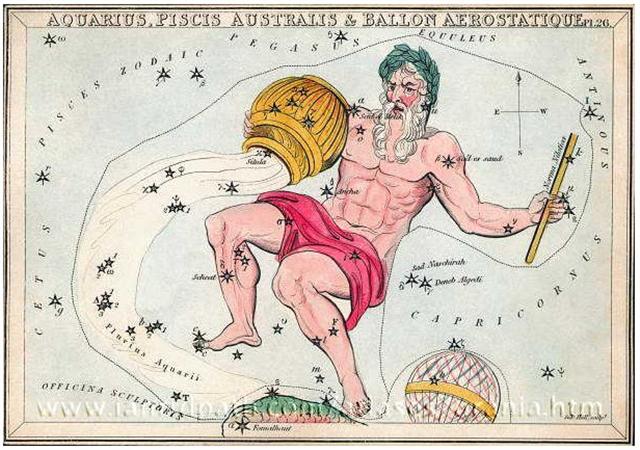
... The
Greek
lettered
κ
(Situla) is
at the rim
of the Urn,
not at the
top of the
Nilometer,
where
instead
there is a
Latin letter
k. The
meaning
obviously is
for the
viewer to
connect k
with
κ,
to imagine
the Rod
inserted
into the Urn
(Tent) at
the K
position ... |
|
JUNE 28 |
29 (180) |
SIRIUS |
JULY 1
(*102) |
 |
 |
 |
 |
|
Ga4-16 |
Ga4-17
(100) |
Ga4-18 |
Ga4-19 |
|
ν Hydrae
(163.1) |
no star
listed
(164)
ALTAIR
(α
Aquilae) |
Wings-27
(Snake)
η Oct.
(165.4),
ALKES =
α
Crateris
(165.6)
*124 =
*165.4 -
*41.4 |
ANA-TIPU-4
(Upper-side-pillar
- where
the
guards
stood)
MERAK
(Loin) =
β Ursae
Majoris
(166.2),
DUBHE
(Bear) =
α Ursae
Majoris
(166.7) |
|
Aug 31 |
Sept 1 |
2 (*165) |
3 (246) |
|
°Aug
27 |
28 |
29
(*161) |
30 (242) |
|
'Aug 4
(216) |
5 (*137) |
6 |
7 |
|
"July 21 |
22 / 7 |
23 (204) |
Anakena
24
HANGA
HOONU
(5
days) |
|
They
came
down
from the
height,
from the
mountain,
from
Pua
Katiki,
and
reached
Maunga
Teatea.
They
looked
around
and gave
the name
Maunga
Teatea A
Hau Maka.
They all
descended,
they all
came
down
from
Pua
Katiki.
They
reached
Mahatua,
saw it,
looked
around,
and gave
the name
Mahatua
A Hau
Maka.
Then
they
went on
and came
to
Taharoa.
They saw
it,
looked
around,
and gave
the name
Taharoa
A Hau
Maka.
Again
they
went on
and
reached
Hanga
Hoonu.
They saw
it,
looked
around,
and gave
the name
Hanga
Hoonu A
Hau Maka
... |
|
CLOSE TO
THE FULL
MOON: |
|
DEC 28 |
29 |
30 (364) |
31
(*285) |
|
Maunga
Teatea |
Mahatua |
Taharoa |
HANGA
HOONU |
|
...
Everywhere
the
dream
soul
looked
around
for
a
residence
for
the
king.
The
dream
soul
went
to
Maunga
Teatea
and
gave
him
the
name
'Maunga
Teatea
A
Hau
Maka
O
Hiva'.
The
dream
soul
of
Hau
Maka
looked
around.
From
Maunga
Teatea
she
looked
to
Rangi
Meamea
(i.e.,
Ovahe).
The
dream
soul
spoke
the
following:
'There
it
is -
ho!
-
the
place
-
ho!
-
for
the
king
-
ho!
- to
live
(there
in
the
future),
for
this
is
(indeed)
Rangi
Meamea.'
The
dream
soul
descended
and
came
to
Mahatua.
She
named
the
place
'Mahatua
A
Hau
Maka
O
Hiva'.
The
dream
soul
continued
to
look
around
for
a
residence
for
the
king.
Having
reached
Taharoa
she
named
the
place
'Taharoa
A
Hau
Maka
O
Hiva'.
The
dream
soul
moved
along
and
reached
Hanga
Hoonu.
She
named
the
place
'Hanga
Hoonu
A
Hau
Maka
O
Hiva'.
On
the
same
day,
when
they
had
reached
the
Bay
of
Turtles,
they
made
camp
and
rested.
They
all
saw
the
fish
that
were
there,
that
were
present
in
large
numbers
-
Ah!
Then
they
all
went
into
the
water,
moved
toward
the
shore,
and
threw
the
fish
(with
their
hands)
onto
the
dry
land.
There
were
great
numbers
(?
ka-mea-ro)
of
fish.
There
were
tutuhi,
paparava,
and
tahe
mata
pukupuku.
Those
were
the
three
kinds
of
fish.
After
they
had
thrown
the
fish
on
the
beach,
Ira
said,
'Make
a
fire
and
prepare
the
fish!'
When
he
saw
that
there
was
no
fire,
Ira
said,
'One
of
you
go
and
bring
the
fire
from
Hanga
Te
Pau!'
One
of
the
young
men
went
to
the
fire,
took
the
fire
and
provisions
(from
the
boat),
turned
around,
and
went
back
to
Hanga
Hoonu.
When
he
arrived
there,
he
sat
down.
They
prepared
the
fish
in
the
fire
on
the
flat
rocks,
cooked
them,
and
ate
until
they
were
completely
satisfied.
Then
they
gave
the
name
'The
rock,
where
(the
fish)
were
prepared
in
the
fire
with
makoi
(fruit
of
Thespesia
populnea?)
belongs
to
Ira'
(Te
Papa
Tunu
Makoi
A
Ira).
They
remained
in
Hanga
Hoonu
for
five
days
...
|
|
ι Cephei
(346.0),
λ
Aquarii,
γ Piscis
Austrini,
σ Pegasi
(346.5) |
SCHEAT
AQUARII
= δ
Aquarii
(347.0),
ρ Pegasi
(347.2),
δ Piscis
Austrini
(347.4),
FOMALHAUT
(Mouth
of the
Fish) =
α Piscis
Austrini,
τ Gruis
(347.8)
*306 =
*347.4 -
*41.4 |
FUM AL
SAMAKAH
(Mouth
of the
Fish) =
β
Piscium
(348.3),
ζ Gruis
(348.5),
ο
Andromedae
(348.9) |
Al Fargh
al
Mukdim-24
(Fore
Spout) /
Purva
Bhādrapadā-26
(First
of the
Blessed
Feet) /
House-13
(Pig)
SCHEAT
PEGASI =
β Pegasi,
π Piscis
Austrini
(349.3),
κ Gruis
(349.4),
MARKAB
PEGASI =
α Pegasi
(349.5)
*308 =
*349.4 -
*41.4 |
|
March 2 |
3 |
4 (*348) |
5 (64) |
|
°Febr 26 |
27 |
28
(*344) |
°March 1
(60) |
|
'Febr 3 |
4 |
5 (36) |
6 (*322) |
|
"Jan 20 |
21 |
22 |
23
(*308) |
 |
| JULY 2 |
3 (*104) |
4 (185) |
 |
 |
 |
| Ga4-20 |
Ga4-21 (104) |
Ga4-22 |
| 11h (167.4 = 126.0 + 41.4)
χ Leonis, χš Hydrae (167.1), χ˛ Hydrae (167.3) |
AL SHARAS (The Ribs) = β Crateris (168.6) |
Al Zubrah-9 (Mane) / Purva Phalguni-11 (First Reddish One - Fig Tree)
ZOSMA (Girdle, not Belt) = δ Leonis (169.2), COXA (Hips) = θ Leonis (169.4)
*169.4 - *41.4 = *128.0 |
|
... God created Eve from one of Adam's ribs and therefore I at first tried to translate the female (β) star Al Sharas with The Rib. Although according to Allen this star was plural: '... β ... was one of Al Tizini's Al Sharāsīf, the Ribs, - i.e. of the Hydra, - and the first of the set.' Adam had, as I remember it, another wife before Eve, viz. Lilith ...

|
|
... Dante kept to the tradition of the whirlpool as a significant end for great figures, even if here it comes ordained by Providence. Ulysses has sailed in his 'mad venture' beyond the limits of the world, and once he has crossed the ocean he sees a mountain looming far away, 'hazy with the distance, and so high I had never seen any.' It is the Mount of Purgatory, forbidden to mortals. 'We rejoiced, and soon it turned to tears, for from the new land a whirl was born, which smote our ship from the side. Three times it caused it to revolve with all the waters, on the forth to lift its stern on high, and the prow to go down, as Someone willed, until the sea had closed over us.' The 'many thoughted' Ulysses is on his way to immortality, even if it has to be Hell. The engulfing whirlpool belongs to the stock-in-trade of ancient fable. It appears in the Odyssey as Charybdis in the straits of Messina - and again, in other cultures, in the Indian Ocean and in the Pacific. It is found there too, curiously enough, with the overhanging fig tree to whose boughs the hero can cling as the ship goes down, whether it be Satyavrata in India, or Kae in Tonga ...

|
 |
|
... There were 80 days from Zosma (the girdle of the Lion) and Coxa (his hips) to Antares. I.e., the distance from "July 27 (208) to 288 ("October 15, Tagaroa Uri 15) corresponded to the distance from January 1 to 0h (the Gregorian equinox). However, according to Manuscript E the Sun king left his old homeland in Hora Nui 2, which should have corresponded to "September 2 rather than to "July 27 (Anakena 27).
... Hotu's canoe sailed from Maori to Te Pito O Te Kainga. It sailed on the second day of September (hora nui) ...
245 ("September 2) - 208 ("July 27) = 37 days = 41 - 4, i.e. according to the Gregorian calendar the Sun would reach °September 2 (245) when the precessional distance down to the time of Bharani was *41 - 4 = 37 days. Manuscript E seems here to have documented that the Sun calendar (the Gregorian calendar) should be used only up to Zosma and Coxa. Or rather that the Gregorian calendar was used in Hiva. |
| Sept 4 |
5 (248 = 104 + 144) |
6 |
| °Aug 31 |
°Sept 1 (244) |
Hora Nui 2 |
| 'Aug 8 (*140) |
9 |
10 (222) |
| "July 25 |
26 |
27 (*128) |
| HANGA HOONU |
| JUNE 25
DEC 25
Hanga Takaure |
26
Poike |
27
Pua Katiki |
28
Maunga Teatea |
29
Mahatua |
JUNE 30 (181)
DEC 30 (364)
Taharoa |
JULY 1
DEC 31
Hanga Hoonu |
| 'July 4 (185) |
5 |
6 |
7 |
8 |
'July 9 (190) |
10 |
| Anakena 18
DEC 31 (365)
Hanga Hoonu |
19
JAN 1
RANGI MEAMEA |
20
2
Peke Tau O Hiti |
21
3 (368)
Maunga Hau Epa |
22
4
Hanga Moria One |
23 (204 = 190 + 14)
5 (370 = 181 + 183 + 6)
OROMANGA |
Anakena 24
DEC 31 (365)
JULY 1 |
| 5 days rest in Hanga Hoonu |
|
| CLOSE TO THE FULL MOON: |
| JAN 1 |
2 |
3 (368) |
| RANGI MEAMEA |
Peke Tau O Hiti |
Maunga Hau Epa |
|
... The dream soul came to Rangi Meamea and looked around searchingly. The dream soul spoke: 'Here at last is level land where the king can live.' She named the place Rangi Meamea A Hau Maka O Hiva. The mountain she named Peke Tau O Hiti A Hau Maka O Hiva. The dream soul moved along a curve from Peke Tau O Hiti to the mountain Hau Epa [Maunga Auhepa], which she named Maunga Hau Epa A Hau Maka O Hiva.
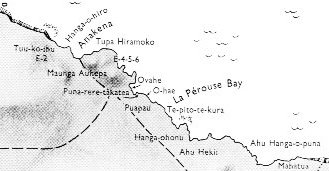
The dream soul went to the other side of the mountain Hau Epa. As soon as the dream soul looked around, she saw the sand (beach), which was very white and light.
She remained there and explored everything. After she had looked around carefully, the dream soul of Hau Maka said, 'Ah! This is the place that will serve as a residence for the king. She named the place Oromanga A Hau Maka O Hiva and also named the neighboring bay Hanga Moria One A Hau Maka O Hiva.
|
| 23h (350.0) = 2 * 175
υ, θ Gruis (350.0), π Cephei (350.6), ι Gruis (350.9) |
SIMMAH = γ Piscium (351.7) |
φ Aquarii (352.0), ψ Aquarii (352.4), χ Aquarii (352.6), γ Tucanae, φ Gruis (352.8)
*352.4 - *41.4 = *311.0 |
| March 6 (*350) |
7 (66) |
8 (432) |
| °March 2 (*346) |
3 |
4 (63) |
| 'Febr 7 |
8 (*324) |
9 (40) |
| "Jan 24 |
25 (*310) |
26 |
| JULY 5 |
6 (*107) |
7 |
8 |
9 (190) |
|
... Midsummer is the flowering season of the oak, which is the tree of endurance and triumph, and like the ash is said to 'court the lightning flash'. Its roots are believed to extend as deep underground as its branches rise in the air - Virgil mentions this - which makes it emblematic of a god whose law runs both in Heaven and in the Underworld ... The month, which takes its name from Juppiter the oak-god, begins on June 10th and ends of July 7th. Midway comes St. John's Day, June 24th, the day on which the oak-king was sacrificially burned alive. The Celtic year was divided into two halves with the second half beginning in July, apparently after a seven-day wake, or funeral feast, in the oak-king's honour ... |
 |
 |
 |
 |
 |
| Ga4-23 |
Ga4-24 |
Ga4-25 (108) |
Ga4-26 |
(111) Ga4-27 (→ 108) |
|
... the first month of the Moriori year, was named Rongo (Lono). On the first of the new year the Moriori launched a small canoe to Rongo, although they built and used only rude craft for their fishing excursions. The canoe was manned by twelve figures symbolizing the personifications of the twelve months ... |
| φ Leonis (170.0), ALULA (First Spring of the Gazelle) = ξ, ν Ursae Majoris (170.5), LABRUM = δ Crateris (170.6) |
σ Leonis (171.1), λ Crateris (171.6), ι Leonis, ε Crateris (171.9) |
γ Crateris, π Centauri (172.0), κ Crateris (172.5), τ Leonis (172.8)
GREDI (α Capricorni)
|
οš Centauri (173.8) |
GIAUZAR = λ Draconis (174.0), ξ Hydrae (174.3), ο˛ Centauri, λ Centauri (174.8) |
 |
| Sept 7 |
8 |
9 (*172) |
10 |
11 (254) |
| °Sept 3 |
4 |
5 (*168) |
6 |
7 (250) |
| 'Aug 11 |
12 (*144) |
13 |
14 |
15 (227) |
| "July 28 |
29 (*130) |
30 |
31 |
"Aug 1 (213) |
| CLOSE TO THE FULL MOON: |
| JAN 4 |
5 (*290) |
6 |
7 (372) |
8 |
| CROSS-BARS |
ο Gruis, Snowball Nebula = NGC7662 Andromedae (355.0), τ Oct. (355.3) *314 (→ π) |
no star listed (356) |
ι Phoenicis (357.3), ι Piscium (357.4), λ Andromedae (357.9) *357.4 -*41.4 = *316 |
| ο Cephei (353.3), KERB (Bucket Rope) = τ Pegasi (353.6) |
κ Piscium (354.2), θ Piscium (354.4), υ Pegasi (354.9) *354.4 - *41.4 = *313 |
 |
| March 9 |
10 (*354) |
11 |
12 |
13 (72) |
| °March 5 |
6 (*350) |
7 |
8 |
9 (68) |
| 'Febr 10 (41) |
11 |
12 |
13 (*329) |
2-14 |
| "Jan 27 |
28 |
29 (*314) |
30 |
31 |
 |
366
+ 93
=
459
= 17
*
27 (=
16 *
29˝
-
13).
In
the
tresses
of
Pachamama
there
were
27
nights
in
number
7 +
6 =
13,
as
if
pointing
at
Pua
Katiki
(the
Sun
at
JUNE
27
with
the
Full
Moon
at
night
number
384),
cfr
Ga4-15:
|
Counting the tresses of Pachamama (the World
Mother) from left to right: |
|
1 |
29 |
90 = 107 - 17 |
1 |
26 |
78
(cfr Ga3-19) |
|
2 |
30 |
2 |
26 |
|
3 |
31 |
3 |
26 |
|
4 |
34 |
214 - 180 |
4 |
25 |
78
(cfr Ga4-15) |
|
5 |
31 |
90 = 107 - 17 |
5 |
26 |
|
6 |
30 |
6 (13) |
27 |
|
7 |
29 |
7 |
26 |
(cfr Ga7-13) |
|
Total = 396 = 214 +
182 |
|
 |
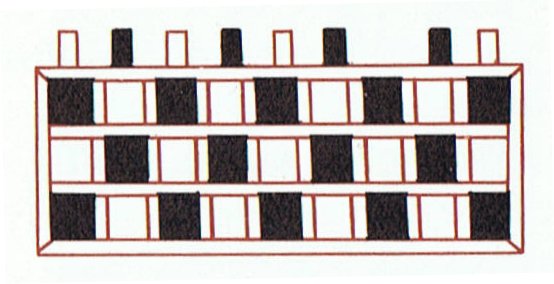
There
were
8
'dogs'
(pieces
to
play
with)
we
can
see,
and
black
dominated.
White
had
one
missing:
...
With
the
elimination
of
Kuukuu,
Makoi
achieves
superior
status
among
the
sons
of
Hua
Tava:
the
last-born
now
holds
the
rank
of
the
first-born.
Through
the
meeting
with
Nga
Tavake,
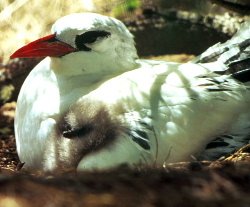
the
representative
of
the
original
population
in
the
area
north
of
Rano
Kau,
the
number
of
the
explorers
is
once
again
complete.
Not
only
are
Kuukuu
and
Nga
Tavake
related
as
'loss'
and
'gain',
but
also
they
share
the
same
economic
function:
it
was
Kuukuu's
special
mission
to
establish
a
yam
plantation
after
the
landing
(in
this
role
he
represents
the
vital
function
of
the
good
planter);
Nga
Tavake
joined
the
explorers
to
work
with
them
in
the
yam
plantation
of
the
dead
Kuukuu
(i.e.,
he
closes
the
gap
caused
by
the
death
of
Kuukuu
among
the
planters)
...
...
This
island
was
once
a
great
land.
The
reason
it
became
so
small
is
because
Uoke
lifted
the
earth
with
a
(mighty)
pole
and
then
let
it
sink
(into
the
sea).
It
was
because
of
the
very
bad
people
of
Te
Pito
O Te
Henua
that
Uoke
lifted
the
land
(and
let
it
crumble)
until
it
became
very
small.
From
the
uplifted
Te
Pito
O Te
Henua,
(they)
came
to
the
landing
site
of
Nga
Tavake,
to
Te
Ohiro.
In
Rotomea
(near
Mataveri)
they
disembarked
and
climbed
up
to
stay
at
Vai
Marama
(a
waterplace
near
Mataveri).
During
the
next
month,
they
moved
on
to
Te
Vare
(on
the
slope
of
the
crater
Rano
Kau).
When
they
saw
that
the
(land-)
lifting
Uoke
also
approached
(their
present)
island,
Nga
Tavake
spoke
to
Te
Ohiro:
'The
land
is
sinking
into
the
sea
and
we
are
lost!'
But
Te
Ohiro
warded
off
the
danger
with
a
magic
chant.
In
Puku
Puhipuhi,
Uoke's
pole
broke,
and,
in
this
way,
at
least
Nga
Tavake's
landing
site
remained
(of
the
formerly
great
land)
...
|
... After naming the topographical features of Easter Island with names from their land of origin, the emissaries went from the west coast up to the rim of the crater Rano Kau, where Kuukuu had started a yam plantation some time earlier.
After they had departed from Pu Pakakina they reached Vai Marama and met a man. Ira asked, 'How many are you?'
He answered, 'There are two of us.' Ira continued asking, 'Where is he (the other)?'
To that he answered, 'The one died.' Again Ira asked, 'Who has died?'
He replied, 'That was Te Ohiro A Te Runu.' Ira asked anew, 'And who are your?'
He answered, 'Nga Tavake A Te Rona.' (E:46)
After this, the emissaries and Nga Tavake went to the yam plantation ... |
|
... RAP. rona means primarily 'sign' (an individual sign in the Rongorongo script or a painted or carved sign made on a firm background, such as a petroglyph), but also 'sculpture' (made from wood or stone, representing animals or hybrid creatures) ...
... rona (lona) implies the idea of 'maintaining a straight line' with ropes and nets and also the maintaining of a steady course (in MAO. and TUA.).
Te Rona is the name of a star in TUA., which Makemson (1941:251) derives from the mythical figure of 'Rona', who is connected with the moon and is considered to be the father of (the moon goddess) Hina (for this role in MAO., see Tregear 1891:423).
From west Polynesia come totally different meanings. Interesting perhaps is FIJ. lona, 'to wonder what one is to eat, fasting for the dead.' ... |
Evidently
the
great
Tau
piece
was lifted
up high
-
cfr
Poike,
the
place
aloft
- by
the
right
front
paw
of
the
Lion
(sitting
on
his
curved
tail)
- while
his
left
paw
held
something
looking
like
a
purse,
...
After
that
they
unwrapped
their
copal
incense,
which
came
from
the
east,
and
there
was
triumph
in
their
hearts
when
they
unwrapped
it.
They
gave
their
heartfelt
thanks
with
three
kinds
at
once:
Mixtam
Copal
is
the
name
of
the
copal
brought
by
Jaguar
Quitze.
Cauiztan
Copal,
next,
is
the
name
of
the
copal
brought
by
Jaguar
Night.
Godly
Copal,
as
the
next
one
is
called,
was
brought
by
Not
Right
Now.
The
three
of
them
had
their
copal,
and
this
is
what
they
burned
as
they
incensed
the
direction
of
the
rising
sun.
They
were
crying
sweetly
as
they
shook
their
burning
copal,
the
precious
copal.
After
that
they
cried
because
they
had
yet
to
see
and
yet
to
witness
the
birth
of
the
sun.
And
then,
when
the
sun
came
up,
the
animals,
small
and
great,
were
happy.
They
all
came
up
from
the
rivers
and
canyons;
they
waited
on
all
the
mountain
peaks.
Together
they
looked
toward
the
place
where
the
sun
came
out
...

...
Gronw
Pebyr,
who
figures
as
the
lord
of
Penllyn
-
'Lord
of
the
Lake'
-
which
was
also
the
title
of
Tegid
Voel,
Cerridwen's
husband,
is
really
Llew's
twin
and
tanist
...
Gronw
reigns
during
the
second
half
of
the
year,
after
Llew's
sacrificial
murder;
and
the
weary
stag
whom
he
kills
and
flays
outside
Llew's
castle
stands
for
Llew
himself
(a
'stag
of
seven
fights').
This
constant
shift
in
symbolic
values
makes
the
allegory
difficult
for
the
prose-minded
reader
to
follow,
but
to
the
poet
who
remembers
the
fate
of
the
pastoral
Hercules
the
sense
is
clear:
after
despatching
Llew
with
the
dart
hurled
at
him
from
Bryn
Kyvergyr,
Gronw
flays
him,
cuts
him
to
pieces
and
distributes
the
pieces
among
his
merry-men.
The
clue
is
given
in
the
phrase
'baiting
his
dogs'.
Math
had
similarly
made
a
stag
of
his
rival
Gilvaethwy,
earlier
in
the
story.
It
seems
likely
that
Llew's
mediaeval
successor,
Red
Robin
Hood,
was
also
once
worshipped
as a
stag.
His
presence
at
the
Abbot's
Bromley
Horn
Dance
would
be
difficult
to
account
for
otherwise,
and
stag's
horn
moss
is
sometimes
called
Robin
Hood's
Hatband.
In
May,
the
stag
puts
on
his
red
summer
coat.
Llew
visits
the
Castle
of
Arianrhod
in a
coracle
of
weed
and
sedge.
The
coracle
is
the
same
old
harvest
basket
in
which
nearly
every
antique
Sun-god
makes
his
New
Year
voyage;
and
the
virgin
princess,
his
mother,
is
always
waiting
to
greet
him
on
the
bank
...
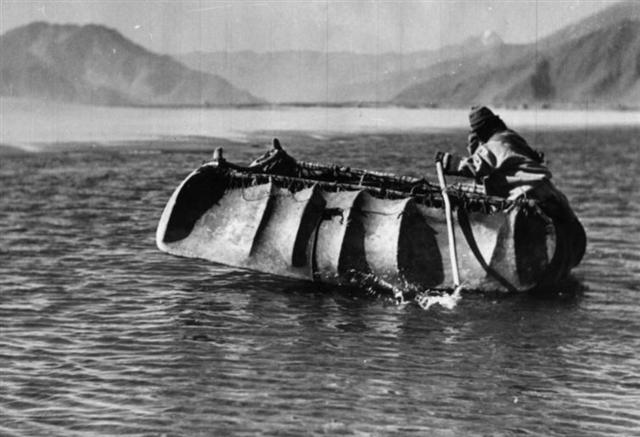
...
The
earth
rises
up
from
the
sea
again,
and
is
green
and
beautiful
and
things
grow
without
sowing.
Vidar
and
Vali
are
alive,
for
neither
the
sea
nor
the
flames
of
Surt
have
hurt
them
and
they
dwell
on
the
Eddyfield,
where
once
stood
Asgard.
There
come
also
the
sons
of
Thor,
Modi
and
Magni,
and
bring
along
his
hammer. There
come
also
Balder
and
Hoder
from
the
other
world.
All
sit
down
and
converse
together.
They
rehearse
their
runes
and
talk
of
events
of
old
days.
Then
they
find
in
the
grass
the
golden
tablets
that
the
Aesir
once
played
with
...
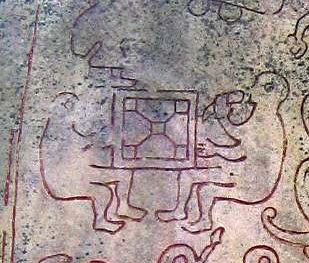


...
A
young
Egyptian
called
Setna
(or
Seton
Chamwese)
wanted
to
steal
the
magic
book
of
Thot
from
the
corpse
of
Nefer-ka
Ptah,
one
of
the
great
Egyptian
gods,
who
was
often
portrayed
as a
mummy.
Ptah,
however,
was
awake
and
asked
him:
'Are
you
able
to
take
this
book
away
with
the
help
of a
knowing
scribe,
or
do
you
want
to
overcome
me
at
checkerboards?
Will
you
play
Fifty-Two?'
Setna
agreed,
and
the
board
with
its
'dogs'
(pieces)
being
brought
up,
Nefer-ka
Ptah
won
a
game,
spoke
a
formula,
laid
the
checkerboard
upon
Setna's
head
and
made
him
sink
into
the
ground
up
to
his
hips.
On
the
third
time,
he
made
him
sink
up
to
his
ears,
then
Setna
cried
aloud
for
his
brother,
who
saved
him
...


8
(black)
+ 1
(green)
+ 17
(bluish)
=
26.
|














.jpg)






























